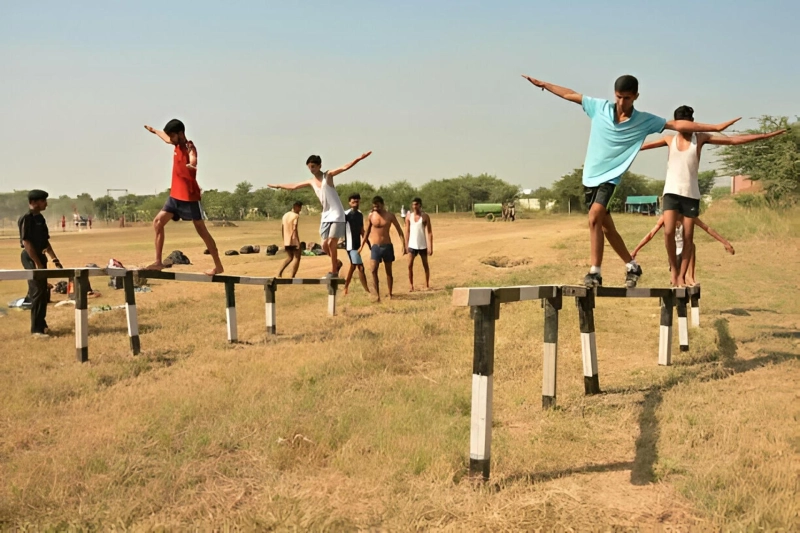Physical fitness is paramount for anyone aspiring to join the army. Army physical training is a fundamental aspect of military life, designed to build strength, endurance, agility, and overall resilience necessary for demanding operational duties. This guide explains the basic exercises commonly included in army physical training and provides insights into a typical daily routine.
Basic Exercises in Army Physical Training:
The specific exercises may vary depending on the unit and the stage of training, but some fundamental movements are consistently emphasized to build a well-rounded level of fitness. These include:
- Running: A cornerstone of army physical training, running builds cardiovascular endurance and leg strength. This often includes:
- Endurance Runs: Long-distance runs to improve stamina.
- Sprints: Short bursts of high-speed running for power and agility.
- Interval Training: Alternating between high-intensity running and recovery periods.
- Push-ups: A classic bodyweight exercise that develops upper body strength, targeting the chest, shoulders, and triceps. Variations may be included to challenge different muscle groups.
- Sit-ups/Crunches: Essential for building core strength and stability, which is crucial for various physical tasks and injury prevention. Different variations can target various abdominal muscles.
- Pull-ups: A challenging exercise that builds upper back, shoulder, and arm strength, as well as grip strength. It's a key indicator of upper body pulling power.
- Squats: A compound exercise that strengthens the legs (quadriceps, hamstrings, glutes) and core, essential for lifting, carrying, and overall lower body power.
- Lunges: Another excellent lower body exercise that improves balance, coordination, and unilateral leg strength.
- Plank: An isometric exercise that builds core endurance and stability. Variations like side planks can target oblique muscles.
- Agility Drills: Exercises designed to improve quickness, coordination, and the ability to change direction. These may include shuttle runs, cone drills, and ladder drills.
- Obstacle Courses: Often incorporated to test a combination of strength, endurance, agility, and problem-solving skills in a physically demanding environment.
- Carrying and Lifting: Exercises that simulate the physical demands of carrying equipment, supplies, or even casualties. This can involve carrying weights, sandbags, or simulated dummies.
Typical Daily Routine Incorporating Army Physical Training:
While the exact schedule can vary significantly based on the unit, location, and training phase, a general daily routine in the army often includes physical training in the morning. Here's a possible outline:
- Early Morning (Pre-Sunrise): Wake-up, personal hygiene.
- Morning PT (Physical Training): This block can last for 1-2 hours and typically includes:
- Warm-up: Light jogging, dynamic stretching (arm circles, leg swings, etc.) to prepare the body for exercise.
- Main Workout: This could focus on cardiovascular training (running, swimming, circuit training), strength training (bodyweight exercises, weightlifting if facilities are available), or agility and obstacle course training. The specific exercises and intensity will vary daily.
- Cool-down: Light jogging or walking followed by static stretching (holding stretches) to aid recovery and improve flexibility.
- Mid-Morning: Breakfast, followed by drills, parades, or classroom instruction depending on the day and training schedule.
- Afternoon: Further training, duties, or maintenance tasks.
- Evening: Sports, individual study, or personal time.
- Night: Dinner, evening briefings, rest.
Important Considerations for the Daily Routine:
- Progression: The intensity and volume of physical training gradually increase over time as individuals become fitter.
- Variety: The daily routine will incorporate a variety of exercises to develop all aspects of physical fitness.
- Recovery: Adequate rest and sleep are crucial components of the daily routine to allow the body to recover from physical exertion.
- Nutrition and Hydration: Regular and nutritious meals and sufficient water intake are essential to fuel the body for training and recovery.
- Unit-Specific Training: Different units may have specialized physical training requirements based on their roles and operational demands.
What is ADC in Army?
The acronym ADC in the army stands for Aide-de-Camp. An Aide-de-Camp is a personal assistant or secretary to a senior officer (of the rank of Captain/Major or equivalent in other services) in the armed forces.
Key functions of an ADC include:
- Assisting the senior officer with their daily tasks and duties.
- Managing schedules and appointments.
- Acting as a liaison between the senior officer and their staff or other individuals.
- Often participating in ceremonial functions and accompanying the senior officer.
- Ensuring the implementation of protocols.
- Managing visitors and coordinating activities.
- In some cases, assisting with advice and security matters.
Being an ADC is considered a prestigious appointment, and officers are typically selected for this role based on their exceptional performance and professionalism. They serve high-ranking officials such as the President of India, Service Chiefs, Army Commanders, and Governors.
Integrating FojFit for Army Physical Training
FojFit offers structured physical training programs designed by ex-defence personnel. These programs can provide a comprehensive approach to army physical training, covering the essential exercises and helping aspirants build the necessary fitness levels for selection and service. While FojFit doesn't directly address the role of an ADC, it focuses on building the foundational physical fitness required for all roles within the armed forces.
Conclusion: Building a Strong Foundation
Army physical training is a rigorous and essential part of military life. By understanding the basic exercises and the principles behind a consistent daily routine, aspiring candidates can effectively prepare themselves for the physical demands of service. Remember that dedication, consistency, and proper recovery are key to achieving and maintaining the required levels of army physical training.


